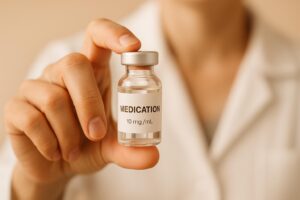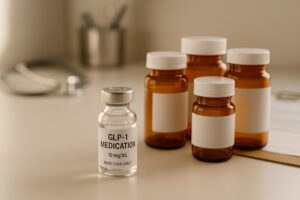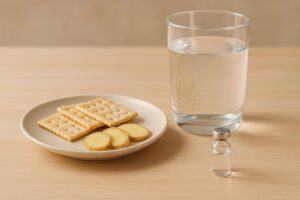What to Eat on a GLP-1: A Comprehensive Guide to Nutrition for Optimal Health

Introduction
Did you know that nearly 70% of U.S. adults are classified as overweight or obese, and many are turning to GLP-1 medications for assistance in their weight loss journeys? These medications, like Semaglutide and Tirzepatide, have gained significant attention for their ability to help manage blood sugar and promote weight loss. However, understanding what to eat while on a GLP-1 medication is crucial for maximizing its benefits and minimizing potential side effects.
As we navigate the landscape of GLP-1 medications, it’s vital to consider not just the impact of the medication itself but also how our dietary choices can aid or hinder our health goals. This blog post aims to provide you with a clear understanding of what foods to embrace and which to avoid when using GLP-1 medications. By the end of this article, we hope you’ll feel empowered to make informed choices that support your health and wellness.
In this comprehensive guide, we will explore:
- The role of GLP-1 medications in weight management and blood sugar control.
- Nutritional priorities while on GLP-1 medications.
- Foods to include in your diet for optimal health.
- Foods to limit or avoid to reduce gastrointestinal side effects.
- Practical meal planning strategies and tips.
Together, let’s dive into the world of nutrition for those on GLP-1 medications, ensuring that every bite you take is both nourishing and beneficial for your health journey.
Understanding GLP-1 Medications
GLP-1 (glucagon-like peptide-1) medications are a class of drugs that mimic the effects of the GLP-1 hormone in the body. Initially developed for the treatment of type 2 diabetes, these medications have been proven effective in promoting weight loss by enhancing insulin secretion, suppressing appetite, and slowing gastric emptying.
However, while these medications can significantly aid in weight loss and glucose management, they also require a commitment to healthy eating habits. Research indicates that individuals taking GLP-1 medications often reduce their caloric intake by as much as 16% to 39%. This makes it even more critical to ensure that the calories consumed are nutrient-dense.
How GLP-1 Medications Affect Eating Habits
When starting GLP-1 therapy, many individuals experience reduced appetite and a prolonged feeling of fullness. This can lead to unintentional reductions in caloric intake, which can be beneficial for weight loss but may also result in nutrient deficiencies if not carefully managed. The medications slow down digestion, which can lead to gastrointestinal side effects like nausea and constipation, making it essential to choose the right foods.
Nutritional Priorities on GLP-1 Medications
Eating well while on GLP-1 medications involves prioritizing foods that are rich in protein, fiber, and healthy fats. Here’s a breakdown of these essential nutrients and their benefits:
Protein
Importance: Protein is crucial for maintaining muscle mass, especially when caloric intake is reduced. It also promotes satiety, helping you feel full longer.
Sources to Include:
- Lean meats (chicken, turkey, and fish)
- Eggs
- Dairy products (Greek yogurt, cottage cheese)
- Legumes (beans, lentils)
- Plant-based options (tofu, tempeh)
Fiber
Importance: Fiber aids digestion and helps combat constipation, a common side effect of GLP-1 medications. It also stabilizes blood sugar levels.
Sources to Include:
- Whole grains (quinoa, brown rice, oats)
- Fruits (berries, apples, pears)
- Vegetables (leafy greens, broccoli, carrots)
- Legumes (chickpeas, lentils)
Healthy Fats
Importance: Healthy fats help in the absorption of fat-soluble vitamins and can improve heart health. They also promote satiety.
Sources to Include:
- Avocados
- Nuts and seeds
- Olive oil and other healthy oils
Foods to Include
When it comes to what to eat on a GLP-1, focusing on whole, minimally processed foods is key. Here’s a list of foods that can support your health while using GLP-1 medications:
1. Lean Proteins
- Chicken and Turkey: High in protein and low in fat.
- Fish: Especially fatty fish like salmon, which also provide omega-3 fatty acids.
- Eggs: A versatile protein source that is nutrient-dense.
2. Vegetables
- Leafy Greens: Spinach, kale, and Swiss chard are excellent choices rich in vitamins and minerals.
- Cruciferous Vegetables: Broccoli, cauliflower, and Brussels sprouts are high in fiber.
3. Whole Grains
- Oats: A great source of soluble fiber that can help manage cholesterol levels.
- Quinoa: A protein-rich grain that is gluten-free and high in essential amino acids.
4. Fruits
- Berries: Strawberries, blueberries, and raspberries are low in sugar and high in antioxidants.
- Apples and Pears: High in fiber and can help keep you full.
5. Healthy Fats
- Nuts and Seeds: Almonds, walnuts, chia seeds, and flaxseeds provide healthy fats and protein.
- Olive Oil: A heart-healthy fat that can be used in cooking and dressings.
Foods to Limit or Avoid
While it’s crucial to know what to include in your diet, it’s equally important to be aware of foods that may exacerbate side effects or hinder your weight loss goals. Here are foods to limit or avoid while on GLP-1 medications:
1. High-Fat Foods
- Fried Foods: Foods that are deep-fried can worsen nausea and digestion.
- Processed Meats: Such as bacon and sausage, which can be high in saturated fats.
2. Sugary Foods
- Sodas and Juices: High in sugar and can lead to spikes in blood sugar levels.
- Sweets and Desserts: Cakes, candies, and pastries should be limited due to high sugar content.
3. Refined Carbohydrates
- White Bread and Pasta: These can cause rapid spikes in blood sugar.
- Pastries and Crackers: Often high in unhealthy fats and sugars.
4. Spicy Foods
- Spicy foods can aggravate gastrointestinal issues, particularly nausea and discomfort.
5. Alcohol
- Alcohol can contribute to dehydration and may increase the risk of hypoglycemia. Moderation is key.
Meal Planning Strategies
Creating a meal plan that aligns with your GLP-1 treatment can make a significant difference in your weight loss journey. Here are some practical strategies to consider:
1. Plan Smaller, Balanced Meals
- Aim for five to six smaller meals throughout the day rather than two or three large meals. This can help maintain energy levels and prevent overeating.
2. Focus on Nutrient-Dense Foods
- Ensure that every meal contains a balance of protein, healthy fats, and fiber-rich carbohydrates to promote satiety and maintain energy levels.
3. Stay Hydrated
- Drink plenty of water throughout the day to help mitigate side effects like constipation and nausea.
4. Be Mindful of Portion Sizes
- Be aware of portion sizes, especially when consuming calorically dense foods like nuts and oils.
5. Keep Healthy Snacks on Hand
- Healthy snacks such as cut vegetables, hummus, or nuts can prevent cravings and keep you on track.
Conclusion
Navigating the world of nutrition while on GLP-1 medications doesn’t have to be overwhelming. By prioritizing nutrient-dense foods and being mindful of what to avoid, you can support your weight loss goals and overall health. Remember that each person’s body responds differently, so it may take some time to find what works best for you.
As you embark on this journey, we encourage you to focus on creating a balanced and varied diet that not only aligns with your health goals but also brings enjoyment to your meals. If you’re looking to further personalize your weight loss journey, consider taking our free assessment quiz to see if you qualify for our prescription weight loss medications, which can provide additional support.
Together, we’ll explore how the right foods can enhance the benefits of your GLP-1 medication and contribute to a healthier, more fulfilling lifestyle.
FAQ
Can I eat carbohydrates while on GLP-1 medications?
Yes, but focus on whole grains and high-fiber carbohydrates to help stabilize blood sugar levels.
How much protein should I aim for daily?
A general guideline is to consume about 1.2 grams of protein per kilogram of body weight.
Are there any specific foods that can help with the side effects of GLP-1 medications?
Foods high in fiber can help with constipation, while ginger tea may alleviate nausea.
How can I stay hydrated while on GLP-1 medications?
Aim for eight to ten glasses of water or sugar-free beverages each day.
Should I consult a dietitian while on GLP-1 medications?
Working with a registered dietitian can provide personalized guidance and meal planning tailored to your needs.
By following these dietary strategies, you can harness the full potential of your GLP-1 medication and embark on a successful journey towards improved health and well-being.

Transforming Lives, One Step at a Time
Keep reading
Ultimate Guide to Semaglutide Dose Customization
This guide explores semaglutide dosing for diabetes and weight loss, emphasizing personalized adjustments for optimal results.
6 Common Drug Interactions with GLP-1 Medications
Learn about six common drug interactions with GLP-1 medications and how to manage potential risks for safe treatment.
Mounjaro Insurance Coverage: What to Know
Learn how insurance coverage for Mounjaro varies based on diabetes treatment and weight loss, along with tips for approval and cost-saving options.
Semaglutide vs. Tirzepatide: Max Dose
Explore the differences between two weight loss medications, their maximum doses, effectiveness, and safety profiles for better health outcomes.
GLP-1 Diet Plan: 7-Day Meal Guide
Learn how to effectively pair GLP-1 medications with nutritious meal planning for weight loss, improved digestion, and stable blood sugar.
Nausea and GLP-1 Medications: Solutions That Work
Learn effective strategies to manage nausea from GLP-1 medications, including dietary tips and the importance of personalized dosing.
5 Signs GLP-1 Medication Is Working for You
Learn the key signs that indicate your GLP-1 medication is effectively aiding weight loss, appetite control, and blood sugar management.
Plateau Problems: Restarting Weight Loss
Stalled weight loss on GLP-1 medications is common but manageable. Explore strategies to break through plateaus and regain momentum.
Body Fat Percentage Estimator – Know Your Stats
Estimate your body fat percentage in seconds with our free tool. Just input your height, weight, and more for instant results. Try it now!









